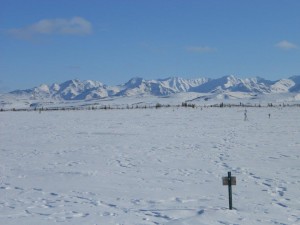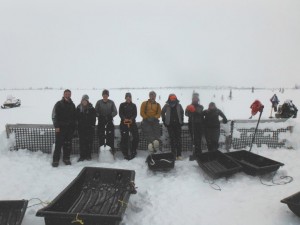11 February 2016
New study suggests northern tundra shifting from carbon sink to carbon source
Posted by Lauren Lipuma
By Lauren Lipuma

A new study suggests that the northern tundra may be shifting to a carbon source.
Credit: Elizabeth Webb
For millennia, the frozen lands of the far Northern Hemisphere have been a huge reservoir of carbon. The permafrost soils that characterize the Arctic and sub-Arctic tundra cover roughly 8 percent of the global land surface but hold half of Earth’s underground organic carbon and twice as much carbon as is currently in the atmosphere.
Arctic tundra stores carbon during the summer and releases some of it during the winter. But a new study shows that carbon released during the winter now outweighs the summertime gains, resulting in a net loss of carbon to the atmosphere.
According to the study’s authors, these results suggest the northern tundra may be shifting from its historical role as a carbon sink to a carbon source. To date, the Arctic has warmed more than any other region globally and researchers expect this warming to continue in the coming decades. If the tundra becomes a carbon source, it could amplify global warming and accelerate climate change, according to the authors.
“The more the Arctic and sub-Arctic warm, the more carbon will be released to the atmosphere in the form of carbon dioxide and methane, which are greenhouse gasses and will trap more heat, warming the high latitudes even more,” said Elizabeth Webb, an ecosystem ecologist at the University of Florida in Gainesville and lead author of the new study.
Webb’s study, published in the Journal of Geophysical Research – Biogeosciences, a publication of the American Geophysical Union, provides a comprehensive analysis of carbon flux on the tundra during the winter months.
“What motivated my study was this interest in what’s happening in the winter, because it’s such an important time of year in the northern latitudes,” Webb said. “The Arctic winter is bearing the brunt of global warming, and we need to be able to quantify how increases in temperature will increase the amount of carbon dioxide lost during the winter.”
A massive carbon freezer
In the tundra, the net carbon flux – the exchange of carbon between the ground and the atmosphere – is a balance between plant photosynthesis and microbial respiration. Plants take in carbon dioxide from the atmosphere and store it as organic carbon. Soil microbes decompose organic material and exhale carbon dioxide through respiration.
But in permafrost, or permanently frozen soils, respiration slows almost to a halt. As a result, the tundra slowly accumulates organic carbon – like a giant freezer storing food underground.
Previous research has shown that even as northern latitudes warm, carbon storage from photosynthesis outweighs losses from respiration. However, most of this research has been done in the short summer season when there is plentiful sunlight to drive photosynthesis. The Arctic is also expected to see greater warming in the winter than in the summer in the coming decades. As temperatures rise, how much stored carbon stored is released during the long, dark winter is “the great unknown,” according to Webb.
Measuring wintertime carbon flux

Webb’s team built snow fences to simulate how warming temperatures would affect carbon flux in the Alaskan permafrost.
Credit: Tom Lane
Webb’s team measured the net carbon flux of tundra in Alaska’s interior during the winter of 2008-2009 through the winter of 2012-2013. The team built snow fences that accumulate snow on one side of a barrier. On the leeward side of the fence, snow accumulates, insulating the soil below and simulating what would happen under warmer temperatures.
On the windward side, no additional snow accumulates, showing what would happen if temperatures remain the same. The soil on the warming side becomes, on average, 1.5 degrees Celsius (2.7 degrees Fahrenheit) warmer than on the non-warming side, according to Webb.
The team detected a net loss of carbon dioxide from the soil to the atmosphere over the five winters studied on both sides of the fence. They found that warmer temperatures increased carbon dioxide loss to the atmosphere between 9 percent and 36 percent, depending on which of four different measurement methods were used.
“Even though we have these different methods of measuring it, we’re still showing the same result, which is that temperature is important,” Webb said. “We weren’t able to clarify the best method, but we found that by using different methods, we could converge on what might be a reasonable estimate of the carbon dioxide that’s lost during the winter.”
Is the vast freezer starting to thaw?
Combined with summertime carbon flux data from three of the study years, Webb’s research showed that during the years analyzed – 2009, 2010 and 2011 – this region of tundra was releasing carbon to the atmosphere, rather than storing it – even on the non-warming side of the fence.
According to Webb, with only a few years of data, it’s too soon to say whether this marks an end to carbon storage in northern permafrost.
“It’s very difficult to make large conclusions just based on three years – it could be a total anomaly,” Webb said. But her data does agree with other field studies and permafrost models that show the tundra is moving from a carbon sink to a carbon source, she said.
“I can’t say if that is a tipping point or not, but I can say that in terms of climate change, it’s not a step in the right direction,” she said. Because the field site for this study was just south of the Arctic Circle, the change at this site might be a good indicator of what is to come farther north, she added.
Previous research has found that even under layers of snow, plants are still taking in carbon late into the fall and before the snow melts in the spring, but researchers had not taken that into consideration when calculating carbon flux during the winter or on an annual basis, according to Webb. The next step for the team will be to spend more time understanding the carbon flux during the fall and spring seasons.
“As climate change progresses, we’re going to see longer shoulder seasons – the fall [and spring] will be lasting longer and the winter will be shorter,” Webb said. “So we need to be able to figure out what’s happening during that time.”
– Lauren Lipuma is a public information specialist and writer at AGU.










 GeoSpace is a blog on Earth and space science, managed by AGU’s Public Information staff. The blog features posts by AGU writers and guest contributors on all sorts of relevant science topics, but with a focus on new research and geo and space sciences-related stories that are currently in the news.
GeoSpace is a blog on Earth and space science, managed by AGU’s Public Information staff. The blog features posts by AGU writers and guest contributors on all sorts of relevant science topics, but with a focus on new research and geo and space sciences-related stories that are currently in the news.